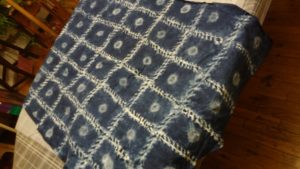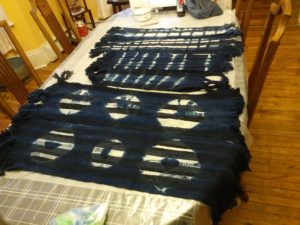Stephen Hamilton is a Boston based artist who employs the “aesthetics, philosophies and key symbols [of] Africa and the Diaspora [in his work. His art and educational initiatives] create a dialogue between contemporary Black cultures and the ancient African world.”
The approach is personal, local and global—Hamilton’s most recent project, which he’ll be talking about Thursday, brings techniques he learned in Nigeria to Boston youth.
7/16 Atlantic Warf Gallery, 290 Congress Street, Boston. 6-8pm 7pm – Artist panel discussion. register here for free
I caught up with him via email to find out more—
Q: What first got you interested in working with textiles?
Stephen Hamilton: I took a class in resist dyeing techniques while studying at MassArt. I also had a strong focus on the art and history of precolonial Africa in my work, which involved doing a lot of research about African textile traditions.
Through this research I learned about the Nike Center for Art and Culture in Nigeria. I received a grant through Arts Connect International that allowed me to travel to Nigeria and study traditional Weaving, Dyeing and Woodcarving techniques at the center. While there I also had the opportunity to do more in depth study on Yoruba religion. The experience has had a gargantuan impact on my work an artist and as an educator.
Q: Can you share a little about the process(dyeing, weaving, etc.)?
SH: Traditional indigo dyeing is a laborious process. To extract the dye, balls of dried indigo leaves are soaked in a lye solution that is created by leaching water through wood or cocoa pod ashes. The mixture is allowed to ferment for 5-7 days before it is ready to use for dyeing cloth or yarns.
This was the process That I learned in Nigeria, however due to the temperamental nature of the fermentation process I decided to use pre-reduced indigo for our project at Atlantic Wharf. Despite [a few adjustments due to time constraints], students are using the same techniques I learned in Nigeria, which include Adire Oniko (Tie and Dye) Adire Alabere (Stitch and Dye) and Aso Ofi (Hand Weaving).
Q: You write about the spiritual significance of indigo on your blog, are there stories behind some of the symbols and patterns that in the textiles as well?
SH: Adire has an entire vocabulary of complex symbols and patterns, one common pattern students used was the moon and fruits pattern said to represent the night sky. Another pattern is the cowrie shell pattern that represents wealth (cowries were used as money in precolonial west Africa) another popular yet time extensive motif that students used was the “Ayo” a representation of the widespread board game we know as Mancala in the United States. I wanted to be sure to allow students to select which patterns and techniques they enjoyed the most when they were developing the individual pieces.
Q: Tell me about the community aspect of this project?
SH: Community engagement is one of the core goals of the NEFA Creative City fellowship that is funding this project. Part of the mission of this project is to engage youth from communities around Boston in traditional West African artistic processes. It was very important to teach these techniques to them as part of the beginning of a sort of cultural revival of traditions that (at one time) were incredibly widespread in west Africa.
There is an important undercurrent of reclamation with this project as well as the hope that these creative practices will filter back into communities of African Descent in the Americas. I also wanted participating students to understand that the space in which we were working and the space in which the piece will be installed are public spaces. This is one of the reasons The Friends of Fort Point Channel has been such an important community partner as getting the public engaged in the area is such an important part of the work they do. As Boston is becoming more and more gentrified it is incredibly important that people still feel a sense of ownership over public areas in the city.

Q: Your research deals with historic West African practices, at the same time there is a really contemporary feel to this work. Can you talk about that connection?
SH: Each of the pieces are designed by students using traditional techniques. Due to this, each part of the installation possesses the unique design aesthetic of the artist. Historic techniques and symbols are rehashed with the modern sensibilities of young artists participating in the project. Part of the beauty of African art forms is their tendency to be both ancient and new at the same time. This is why it is so meaningful when people can incorporate these art forms into their contemporary arts praxis. It speak to their versatility and continued relevance.
Q: You’re also a painter. And you’re making a graphic novel. Has your textile and teaching work influenced these other projects?
SH: The graphic novel (Itan: Part 1) incorporates traditional West African textile and sculpture art forms with western painting and illustration. It is very important to me that these traditional arts are also highlighted in the work. This is meant to pay homage to the beauty and sophistication of Yoruba art and aesthetics.
My teaching praxis has also influenced the work as the models for the characters in the stories are my former students. As the comic is an exploration into Yoruba Oral literature, there is also a strong educational component. Like most of my other work, it exists at the intersection of fine, commercial and community arts as well as arts education and cultural empowerment.
Panel discussion: Thurdsay July 16th. Atlantic Warf Gallery, 290 Congress Street, Boston. 6-8pm 7pm – Artist panel discussion. register here for free




